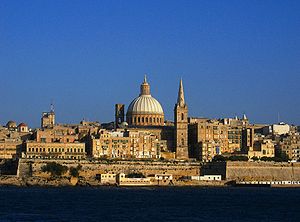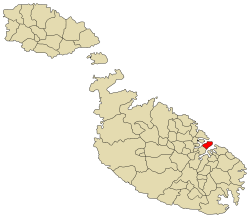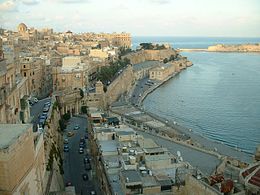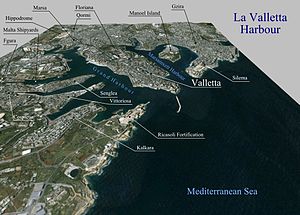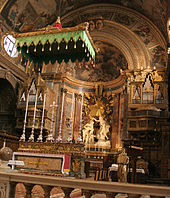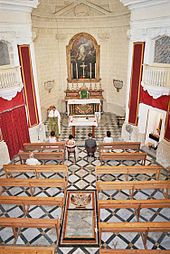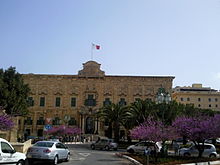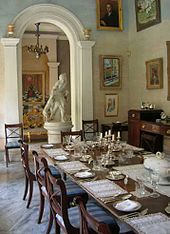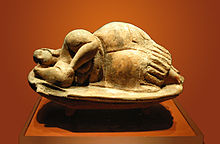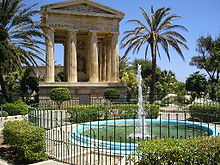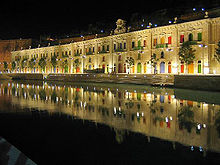- Valletta
-
Il-Belt Valletta
Ċittà Umilissima— City and Local council — Humilissima Civitas Valletta Valletta skyline 
Coat of armsNickname(s): Il-Belt Motto: Città Umilissima Location within Malta Coordinates: 35°53′52″N 14°30′45″E / 35.89778°N 14.5125°E Country  Malta
MaltaIsland Malta District Government – Mayor Alexiei Dingli (PN) Area – Total 0.8 km2 (0.3 sq mi) Elevation 56 m (184 ft) Population (December 2008) – Total 6,098 – Density 7,622.5/km2 (19,742.2/sq mi) Demonym Belti (m), Beltija (f), Beltin (pl) Postal code VLT Dialing code 356 Patron Saints Saint Dominic, Our Lady of Mount Carmel, Saint Paul, Saint Augustine Feast Days August 3 & February 10 Website Official website City of baby Valletta * UNESCO World Heritage SiteCountry Malta Type Cultural Criteria i, vi Reference 131 Region ** Europe and North America Inscription history Inscription 1980 (4th Session) * Name as inscribed on World Heritage List
** Region as classified by UNESCOValletta is the capital of Malta, colloquially known as Il-Belt (English: The City) in Maltese. It is located in the central-eastern portion of the island of Malta, and the historical city has a population of 6,098.[1] The name "Valletta" is traditionally reserved for the historic walled citadel that serves as Malta's principal administrative district. However, Valletta, like many historical city centres, forms part of a larger continuous urban agglomeration; this is often referred to as "Greater Valletta." According to Eurostat, (Greater) Valletta has a population of 368,250 at the city level.[2]
Valletta contains buildings from the 16th century onwards, built during the rule of the Order of St. John of Jerusalem, also known as Knights Hospitaller. The city is essentially Baroque in character, with elements of Mannerist, Neo-Classical and Modern architecture in selected areas, though World War II left major scars on the city. The City of Valletta was officially recognised as a World Heritage Site by UNESCO in 1980.[3]
The city is named for Jean Parisot de la Valette, who succeeded in defending the island from an Ottoman invasion in 1565. The official name given by the Order of Saint John was Humilissima Civitas Valletta — The Most Humble City of Valletta, or Città Umilissima in Italian. The bastions, curtains and ravelins along with the beauty of its Baroque palaces, gardens and churches, led the ruling houses of Europe to give the city its nickname Superbissima — 'Most Proud'.
Contents
Government
Alexiei Dingli has been the Mayor of Valletta since 2008. He was elected on the Nationalist Party Ticket (PN), an affiliate of the European People's Party, which holds the majority of the Council.
History
The city is on the island of Malta so it shares its early history with the island. Immediately after the end of the Siege of Malta in 1565, the Order decided to found a new city on the Xiberras peninsula to fortify the Order's position in Malta and bind the Knights to the island. The foundation stone of Valletta was laid by the Grandmaster of the Order, Jean Parisot de la Valette on 28 March 1566. La Valette placed the first stone in Our Lady of Victories Church.
In his book Dell’Istoria said "Iegi zimen en fel wardia col sceber raba iesue uquie" (Which in modern Maltese reads, "Jiġi żmien li fil-Wardija [l-Għolja Sciberras] kull xiber raba’ jiswa uqija," and in English, "There will come a time when every piece of land on Sciberras Hill will be worth its weight in gold").[4]
Grand Master La Valette died on 21 August 1568 at age 74 and never saw the completion of his city. Originally interred in the church of Our Lady of the Victories, his remains now rest in St. John's Co-Cathedral among the tombs of other Grand Masters of the Knights of Malta. Francesco Laparelli was the city's principal designer and his plan departed from medieval Maltese architecture, which exhibited irregular winding streets and alleys. He designed the new city on a rectangular grid, and without any collacchio (an area restricted for important buildings). The streets were designed to be wide and straight, beginning centrally from the City Gate and ending at Fort Saint Elmo overlooking the Mediterranean; certain bastions were built 153 feet (47 m) tall. The Maltese architect Gerolamo Cassar was responsible for a number of the buildings.
After the Knights' departure and the brief French occupation, building projects in Valletta resumed under British rule. These projects included widening gates, demolishing and rebuilding structures, widening newer houses over the years, and installing civic projects.
Nazi and Fascist air raids throughout World War II caused much destruction. The Royal Opera House, constructed at the city entrance in the 19th century, was one of the buildings lost to the raids.
In 1980, the 24th Chess Olympiad took place in Valletta.
Geography
The Valletta peninsula has two natural harbours, Marsamxett and the Grand Harbour. The Grand Harbour is Malta's major port, with unloading quays at Marsa. A cruise-liner terminal is located along the old seawall of the Valletta Waterfront that Grandmaster Manuel Pinto de Fonseca built.
Climate
Valletta features a Mediterranean climate with very warm, dry summers and mild, wet winters. Like other cities with this climate, Valletta experiences a lack of precipitation during the summer months and heavier precipitation during the winter months. During the winter months, temperatures are moderated somewhat by the city’s proximity to the sea. As a result Valletta enjoys mild, but not chilly, winters. Average high temperatures range from around 15 °C (59 °F) in January to about 30 °C (86 °F) in August, while average low temperatures range from around 10 °C (50 °F) in January to 22 °C (72 °F) in August.
Climate data for Valletta Month Jan Feb Mar Apr May Jun Jul Aug Sep Oct Nov Dec Year Record high °C (°F) 24.5
(76.1)23.7
(74.7)25.6
(78.1)30.2
(86.4)33.8
(92.8)38.9
(102.0)41.9
(107.4)43.1
(109.6)35.8
(96.4)30.0
(86.0)26.2
(79.2)24.3
(75.7)43.1
(109.6)Average high °C (°F) 15
(59)15
(59)16
(61)18
(64)22
(72)26
(79)30
(86)30
(86)27
(81)23
(73)19
(66)16
(61)21 Daily mean °C (°F) 12
(54)12
(54)13
(55)15
(59)18
(64)22
(72)26
(79)26
(79)24
(75)21
(70)16
(61)13
(55)18 Average low °C (°F) 9
(48)9
(48)10
(50)12
(54)15
(59)18
(64)21
(70)22
(72)20
(68)17
(63)13
(55)11
(52)15 Record low °C (°F) 0.4
(32.7)0.6
(33.1)2.8
(37.0)4.1
(39.4)5.7
(42.3)7.2
(45.0)8.5
(47.3)8.2
(46.8)6.5
(43.7)4.3
(39.7)1.7
(35.1)0.1
(32.2)0.1
(32.2)Precipitation cm (inches) 8.9
(3.5)5.6
(2.2)4.7
(1.85)2.8
(1.1)1.3
(0.51)0.3
(0.12)0.2
(0.08)0.1
(0.04)3.1
(1.22)7.9
(3.11)9.2
(3.62)10.3
(4.06)54.4
(21.42)Source: Weatherbase[5] Cityscape
Valletta's streets and piazzas contain architecture ranging from the early 16th century to Modernist in design. The city serves as the island's principal cultural centre and its unique collection of churches, palaces and museums attract visitors from around the world.
When Benjamin Disraeli, future British Prime Minister, visited the city in 1830, he described it as "a city of palaces built by gentlemen for gentlemen," and remarked that "Valletta equals in its noble architecture, if it does not excel, any capital in Europe," and in other letters called it "comparable to Venice and Cádiz" and "full of palaces worthy of Palladio."[6][7]
Buildings of historic importance include St John's Co-Cathedral, formerly the Conventual Church of the Knights of Malta. It has the only signed work and largest painting by Michelangelo Merisi da Caravaggio. The Auberge de Castille et Leon, formerly the official seat of the Knights of Malta of the Langue of Castille, Léon and Portugal, is now the office of the Prime Minister of Malta. The Magisterial Palace, built between 1571 and 1574 and formerly the seat of the Grand Master of the Knights of Malta, now houses the Maltese Parliament and offices of the President of Malta.
The National Museum of Fine Arts is a Rococo palace dating back to the late 1570s, which served as the official residence of the Commander-in-Chief of the Mediterranean Fleet during the British era from 1789 onwards. The Manoel Theatre (Maltese: Teatru Manwel) was constructed in just ten months in 1731, by order of Grand Master Antonio Manoel de Vilhena, and is one of the oldest working theatres in Europe. The Mediterranean Conference Centre was formerly the Sacra Infermeria. Built in 1574, it was one of Europe's most renowned hospitals during the Renaissance. The fortifications of the port, built by the Knights as a magnificent series of bastions, demi-bastions, ravelins and curtains, approximately 100 metres (330 ft) high, all contribute to the unique architectural quality of the city.
Public housing is located within Valletta's walls. Originally the Order planned to construct for its navy a man-made anchorage in the area known as Manderaggio (Maltese: il-Mandraġġ), but never completed this plan. Instead, the area became a jumble of buildings with dark alleyways. In the 1950s, the city partially demolished the Manderaggio and rebuilt it as a housing estate.
Churches
Our Lady of Victories Church was the first building completed in Valletta, built by the Knights of Malta between 1573 and 1578. The body of Jean Parisot de la Valette was entombed there until the construction of St. John's Co-Cathedral. It was commissioned in 1572 by Grand Master Jean de la Cassière as the conventual church of the Knights of Malta. The Church was designed by the Maltese military architect Gerolamo Cassar, architect of the Knights of Malta.
St Francis of Assisi Church (Maltese: San Franġisk t'Assisi) was erected in 1598 but significantly rebuilt through the munificence of Grand Master Gregorio Carafa in 1681. The Parish Church of St Augustine (Maltese: il-Knisja ta' Santu Wistin) is contemporary to the creation of Valletta and its foundation stone was laid in 1571. It was built according to the plan and guidance of Geralomo Cassar. The church was rebuilt in 1765 by Giuseppe Bonnici and was elevated to parish church in 1968.
Maltese Jesuit Fra Andrea opened a conservatory for girls in 1692. Fr Andrea received charitable collections from the Knights of Malta and wealthy Maltese. Christ the Redeemer Church (Maltese: Kristu Redentur), commonly known as Sagaramentini Church for the Perpetual Adoration, is part of this building. The Church of the Jesuits (Maltese: il-Knisja tal-Ġiswiti) is amongst the oldest churches in the City. St Ignatius of Loyola, founder of the Society of Jesus in 1534, had considered founding a college in Malta as early as 1553. Through a letter dated 1592-03-28, Pope Clement XIII solicited the setting up of the Jesuit College and its church.
The Collegiate Parish Church of St Paul's Shipwreck (Maltese: San Pawl tal-Ħġejjeġ) contains the wooden statue of St. Paul the Apostle carved in 1657 by Melchiorre Gafà, brother of Lorenzo Gafà who renovated the church in 1680. The church contains two first-class relics, the right wrist-bone of St. Paul and part of the column on which he was beheaded in Rome.
The Franciscan Church of St Mary of Jesus is popularly known as Ta' Ġieżu in Maltese. It was built in 1571, following the design of Gerolamo Cassar. The facade was replaced in 1680 by Mederico Blondel. Numerous Grandmasters contributed lavishly towards the embellishment of the church, which hosts various works of art. These include the Miraculous Crucifix brought to Malta from Sicily[ in 1630 and a painting of Our Lady of Sorrows by Stefano Erardi. The Blessed Nazju Falzon is entombed within the Franciscan Church.
Numerous other Roman Catholic churches within Valletta include Our Lady of Pilar Church, the Carmelite Church, Our Lady of Liesse Church, St. James Church, St. Barbara Church (offering services in French and German), Our Lady of Damascus (offering services in Greek), St. Lucy Church, St. Roch Church, St. Catherine of Italy Church (offering services in Italian), St. Nicholas Church (known as the 'Church of All Souls'), St. Catherine of Alexandria Church and the Parish Church of Saint Mary of Porto Salvo and Saint Dominic, accredited the first basilica in Malta in the Bolla Pont by Pope Pius V.
There are several Protestant churches in Valletta, catering to the needs of minority denominations. St Paul's Anglican Cathedral is a Pro-Cathedral commissioned by Queen Adelaide on a visit to Malta, when she discovered there was no permanent place of Anglican worship on the island. St. Andrew's Scots Church is a joint congregation (a "Local Ecumenical Partnership") of the Church of Scotland and the Methodist Church of Great Britain. For Church of Scotland purposes it is part of the Presbytery of Europe and is the only Reformed Church in Malta.
Palaces
Valletta contains a great number of palaces, as befits its Renaissance nickname, Superbissima (The proudest, the most illustrious). Some of these palaces served as the auberge for a particular langue of Knights, although some knights also had their own private residences. Other palaces were built by members of the nobility or foreign aristocracy.
The Magisterial Palace of the Grandmaster currently houses the House of Representatives of Malta and the office of the President of Malta. The palace is built around two courtyards, one of which is dominated by a statue of Neptune. There are two entrances in the front and one entrance from Piazza Regina just west of the National Library. The Armoury, housing one of the finest collections of Medieval and Renaissance weapons in all of Europe, runs the width of the back of the palace. The palace also features Gobelin tapestries and frescos by Matteo Perez d'Aleccio (a student of Michelangelo) amongst other treasures.
The Auberge de Castille was the official seat of the knights of the Langue of Castille, León and Portugal – one of the most powerful of the Order, its Head being the Grand Chancellor. The Knights of this Langue were responsible for the defence of part of the fortifications of Valletta known as the St Barbara Bastion. The original Auberge was built by the renowned Maltese architect Girolamo Cassar in 1574. It was extensively re-modelled and virtually rebuilt in 1741, the present plan of the imposing structure attributed to Andrea Belli.
The Auberge d'Aragon is a palace also designed by Girolamo Cassar, in 1571 five years after the establishment of the city. The residents of the palace were initially knights of Aragon, Navarre, and Catalonia. The Auberge de Provence is another of Cassar's masterpieces of Renaissance architecture, built between 1571-75. The Auberge was the residence of the Langue de Provence, its Head, the “Gran Commandeur” being the Treasurer of the Order. From 1824 to 1954 the building housed the British officers’ Union Club, and is now the National Museum of Archeology.
Construction for the Auberge d’Italie was begun in 1574. The building was constructed around an arcaded courtyard and received considerable alteration in the 17th century. Situated in the upper part of Merchants street and in front of another notable building, Palazzo Parisio, it has a fine facade designed by Romano Carapecchia. It now houses the Malta Tourism Authority.
Opposite the Jews' Sally Port (Maltese: Il-Fossa) in Valletta is the Auberge de Bavière built in 1696). Originally intended as a private palace, from 1784 on it was used to accommodate Bavarian and English knights. It now houses Malta's Ministry of Justice and Home Affairs.
Casa Rocca Grande was built by Fra Pietro La Rocca, Prior of Santo Stefano, towards the end of the 16th century and formed part of a magnificent palace with double entrances in the style of the Grandmaster's Palace. It was later divided into two palaces, Palazzo Marina and Messina Palace. For a short time the palace used by the Maltese Government as the Department of Education and later as the Ministry of Education. Messina Palace was leased to the German-Maltese Circle in 1975 until it was purchased by the Circle with the financial assistance of the Government of the Federal Republic of Germany in 1989.
Casa Rocca Piccola is one of the last remaining unconverted palaces currently inhabited by the nobility, in this case the de Piro family. The palace is open to the public; it is the only occupied aristocratic residence in Valletta open to the public.
Opposite the ruins of the Royal Opera House stands Palazzo Ferreria. Its façade resembles a Venetian palace. Popularly known as Palazzo Francia, surname of the family that built and owned it, it originally housed the Knights' foundry - hence the name Ferreria. It today houses a number of offices and retail outlets.
In the early 18th century Bishop Sceberras built the Palazzo Parisio, Valletta on the site of two former houses in Merchants' Street, then known as Strada San Giacomo. Palazzo Parisio consists of three elements, each two storeys high, enclosing a central courtyard, all in a Neo-Classical style.
Napoleon Bonaparte stayed there briefly after taking Valletta on June 11, 1798. He made it his headquarters for five days during his brief plundering stay en route to the Egyptian campaign. Left dilapidated by the late 19th century, it was sold to the Government and fully restored and refurbished. Palazzo Parisio formally opened its doors to the public under the British on 8 May 1886, as Malta’s General Post Office. Today it holds the Ministry of Commonwealth and Foreign Affairs. This palace is not to be confused with Palazzo Parisio in Naxxar, a private property.
Palazzo Castellania is also located along Merchants' Street and was begun to the designs of Maltese architect Francesco Zerafa in 1748. It replaced an earlier building and housed the Civil and Criminal Courts. Zerafa died in 1758 and Giuseppe Bonici was called in to complete the building, which he did by 1760. The building's centrepiece shows stone figures of Justice and Truth. It is now the Ministry of Social Policy.
The National Museum of Fine Arts is housed within an elegant palace in South Street. It was known as Admiralty House when it became the official residence of the Commander-in-Chief of the British Mediterranean fleet. The building dates back to the late 1570s. The palace was the private residence of a succession of knights of the Order of St John. It was opened as a museum in 1974, as a repository of Malta's permanent national art collection.
Museums
The National Museum of Fine Arts is home to works of art that were originally displayed in buildings of the Order, such as the Grand Master's palaces and churches, as well as paintings by Mattia Preti and J. M. W. Turner. Prior to its conversion into a museum, it was a residence. The Order acquired the building in the mid-18th century and transformed it into a Rococo palace. After the departure of the Order from Malta in 1798, the State took over the administration of the building and its contents.
Paintings and sculptures were brought together in the early years of the 20th century and formed the core of the Fine Arts Collection within the National Museum by 1922. Subsequently, individuals and organisations made important donations and bequests to the collection, in addition to acquisitions made throughout the years. The highlight of the 19th century collection is a watercolour by J. M. W. Turner of the Grand Harbour. A number of Old Master works, including as drawings by Pietro Perugino (1450–1523), Vittore Carpaccio (1465–1526) and Mattia Preti (1613–1699), may be viewed under controlled lighting.
The Grandmaster's Palace Armoury Museum exhibits a collection of full suits of armour, arms and guns dating back to the 15th century. During the 1850s, the British Government intended to remove the collection to London. Although they removed some items, local opposition blocked the complete looting of the collection. Instead, in 1860 the Armory was officially opened as Malta’s first public museum. The collection of Renaissance weapons and armour is unique and includes suits of armor that belonged to grandmasters Fra Martin Garzes and Fra Alof de Wignacourt, as well as suits of parade armour that expert armourers had created. The museum displays Italian, German, French and Spanish arms and a number of ornate bronze cannons.
The National War Museum is located within Fort Saint Elmo, a focal point during the Great Siege that rose to prominence once again during World War II. The Museums Department and the National War Museum Association established the museum, which opened to the public in 1975; the museum reopened in 2008 after having been closed for more than a year for refurbishment. The museum building was originally a powder magazine; during the Second World War anti-aircraft gun crews trained there. The Museum highlights Malta’s military role in the post-1800 period under British rule, and memorializes especially the suffering and the heroism that characterised Malta during the Second World War.
The museum offers a walking tour through history, from World War One to the Inter-Wars period, 1939, 1940, 1941, 1942 and so on. It includes a Memorial area, with photographic panels that depict the conditions that prevailed in Malta during the War years 1940-1943. These photographs show the hardships the civilian population endured, the extent of war damage, the unhealthy living conditions within underground shelters and above all, the people who withstood the siege.
The museum's main hall has several World War II relics: an Italian E-Boat, a Bofors anti-aircraft gun, the Willys Jeep ‘Husky’, and the Gloster Gladiator ‘Faith’. Also on display are the George Cross, awarded to the people of Malta by King George VI, the Book of Remembrance of civilians and servicemen killed during the years 1940-43 and the illuminated Scroll that President Franklin D. Roosevelt presented to the “People and Defenders of Malta” in 1943. Also on display are awards and decorations to individual Maltese servicemen and civilians during the War for their acts of bravery and sacrifice above and beyond the call of duty.
The Auberge De Provence houses the National Museum of Archaeology. This palace once served knights from the langue of Provence. The Museum features artifacts from Malta's Neolithic culture, displaying objects collected from the first free-standing structures built on Earth, 5,500 years ago.
The National Museum of Archaeology displays an exceptional array of artifacts from Malta’s prehistoric periods starting with the first arrival of man in the Ghar Dalam phase (5200 BC) and running up to the Tarxien phase (2500 BC). The collection includes obsidian cores and the Red Skorba figurines, which are predecessors of temple period objects and statuary, as well as pottery, worked flint, beads and other ornaments.
The museum's main hall is devoted to temple carvings, in particular the giant statue and altar blocks from the Neolithic Tarxien Temples. The collection continues with representations of animals, temple models and human figures. There are statuettes of the "Sleeping Lady" (Maltese: Mara Rieqda) found in the Hypogeum, and the "Venus" (Maltese: Venere) of Hagar Qim. There is also a large top floor salon with painted walls and a wooden beamed ceiling, currently displaying plans by Renzo Piano for the renovation of the entrance to Valletta. The building was inaugurated as the National Museum in 1958.
The nearby Manoel Theatre Museum presents the history of Valletta's first playhouse, one of the oldest in Europe. It traces the history of theatre on the Maltese Islands through displays of memorabilia assembled from a wide range of sources, both public and private, including donations from private collectors. Works in the Maltese language are also displayed.
The Domus Pauli Museum is located within an extension of the Chapter Hall of the Collegiate Church of St. Paul’s Shipwreck. The museum, in St Paul’s Street, exhibits antique and precious items from St Paul's Shipwreck Church, including relics of St Paul.
St John's Co-Cathedral Museum adjoins the Co-Cathedral and contains Medieval and Renaissance art objects, together with ecclesiastical artifacts. Amongst the contents of the museum are the tapestries of Grandmaster Fra Ramon Perellos de Roccaful, portraits of Grandmasters Fra Jean de la Cassiere, Fra Nicolas Cotoner and Fra Manuel Pinto da Fonseca and paintings that were once kept in the Co-Cathedral's many side chapels such as "St George killing the Dragon" by Francesco Potenzano.
The museum displays a number of bronze and plaster sculptures by the Maltese artist Antonio Sciortino (1879–1947) and paintings by Edward Caruana Dingli (1876–1950). There is also a display of Maltese silverware from the national collection, including liturgical artifacts from churches that formerly belonged to the Order, as well as a collection of silver snuffboxes amongst other silverware. There are various other displays and exhibits.
Valletta's Toy Museum contains an extensive collection of Corgi, Dinky and Matchbox cars. Its three floors house other Maltese and international toys, from the 1950s onward.
Theatres
Manoel Theatre (Maltese: Teatru Manwel) is Europe's third-oldest working theatre. Located on Old Theatre Street, it is now Malta's National Theatre and home to the National Orchestra of Malta. The Manoel is a small, six-hundred and twenty-three seat venue with a lavish, oval-shaped auditorium, three tiers of boxes constructed entirely of wood and decorated with 22-carat gold leaf and a pale blue, trompe-l'oeil ceiling that resembles a rounded cupola.
Countless celebrities have graced its stage, including Boris Christoff, Sir Yehudi Menuhin, John Neville, Magda Olivero, Michael Ponti, Mstislav Rostropovich, Dame Margaret Rutherford, Dame Kiri Te Kanawa and Sir Donald Wolfit. Visiting companies have included Nottingham Playhouse, the Comédie-Française and the Staatsoper Unter den Linden.
The Royal Opera House was an opera house and performing arts venue designed by English architect Edward Middleton Barry, erected in 1866. The theatre was bombed to the ground during World War II in 1942. The space is still used for present day performances and plans to re-build or somehow renovate the area are at a stalemate. The Maltese government has commissioned architect Renzo Piano to build a new Royal Opera House. This is part of a project to renovate the entrance to Valletta.[8] However, Piano's plans remain the subject of fierce controversy.[9]
St James Cavalier also serves as a theatrical space and is a popular venue for local performances. The Old University Theatre is sometimes used by Maltese troupes or drama institutions.
Gardens
The Upper Barrakka Gardens (Maltese: Il-Barrakka ta' Fuq) offer a panoramic view of the Grand Harbour. They were first constructed in 1661 for the private use of knights from the Italian langue. It was not before 1824 that the gardens were opened to the public. The garden suffered extensive damage throughout the Second World War.
The garden paths are lined with busts, statues and plaques illustrating various personalities and significant events from Maltese history. Of special interest are the bronze group by Maltese sculptor Antonio Sciortino, entitled Les Gavroches (English: the Street Urchins). Its depiction of three running children reflects those extreme hardships faced by the people of Malta at the turn of the 20th century.
Also overlooking the Grand Harbour and Breakwater, the Lower Barrakka Gardens (Maltese: Il-Barrakka t'Isfel) offer views of Fort Ricasoli, Bighi Palace, Fort St Angelo and the creeks of Vittoriosa and Kalkara. The gardens contain two major monuments, one dedicated to Sir Alexander Ball and another in remembrance of the Great Siege of Malta. Sir Alexander Ball led Maltese insurgents against the French in the 1798 uprising, and went on to become the first British Governor of Malta.
Located on top of the bastions on the west side of City Gate, Hastings Gardens (Maltese: Ġnien Hastings) affords clear views of Sliema, Manoel Island and Marsamxett Harbour. The garden houses a monument built by the Hastings family dedicated to Francis, Marquis of Hastings, also Governor of Malta. He died in 1827 en route to Naples and his body was returned for burial in this garden.
Forts
Fort Saint Elmo (Maltese: Forti Sant’Iermu) stands on the seaward shore of the Sciberras Peninsula, dividing Marsamxett Harbour from the Grand Harbour. Since the mid-20th century, Fort Saint Elmo has housed Malta's police academy. The War Museum also occupies part of the Fort. It commands the entrances to both harbours and prior to the arrival of the Knights of Malta in 1530, a watchtower existed on this point. Reinforcement of this strategic site commenced in 1533.
By the time of the Ottoman Siege of Malta in 1565, this fortification had been reinforced and extended into a modest star fort. Fort Saint Elmo was the scene of some of the most intense fighting of the siege, and withstood massive bombardment from Turkish cannon deployed from batteries on the north arm of Marsamextt Harbour, present site of Fort Tigne.
During the bombardment of the fort, a cannon shot from Fort St Angelo across the Grand Harbour struck the ground close to the Turkish battery. Debris from the impact mortally injured the corsair and Admiral Turgut Reis (Maltese: Dragut), an Ottoman hero. Though the fort was reduced to rubble during the bombardments, when the Ottomans abandoned the siege the fort was rebuilt and reinforced, becoming partially incorporated into the seaward bastion of the fortress city of Valletta.
Faced with the continuing threat of Turkish attack and the weaknesses caused by the Great Siege of Malta (1565), the Knights of Malta were made to decide whether to abandon the island or attempt its restoration. Grandmaster Jean Parisot de la Valette preferred to stay and ask for aid, which promptly arrived from several quarters, most notably Pope Pius V, who sent not only financial assistance but also the famed military engineer Francesco Laparelli de Cortona. It is Laparelli, succeeded by Maltese architect Gerolamo Cassar, who masterminded the plan of Valletta as we see it today.
Saint James Cavalier (Maltese: Il-Kavallier ta' San Ġakbu) was designed by Laparelli and Cassar, as a raised platform on which guns were placed to defend the city against attacks from the land (Floriana) side. As well as prohibiting entry, St James could threaten those who had already breached the city's defences. Under the British, St. James was converted into an officers' mess. During the latter part of British rule, St. James was turned into a food store, known as the NAAFI.
St James is now a "Centre for Creativity", hosting various theatrical and musical performances, also providing installation and gallery space. Its interior was extensively renovated by Maltese architect Richard England alongside Michael Ellul. The design received a mixed reception from the Maltese public. The national heritage organization Fondazzjoni Wirt Artna protested against the removal of a rare World War II gas shelter and other historical remains from the British period. While the restoration of St James Cavalier was intended as the first phase in a larger project aiming to radically alter Valletta, it has so far been halted at planning stages and is the subject of much local controversy.
Other sites
The Phoenicians erected a tower on the site now occupied by the city, a tower that the Greeks and Romans also used. Today, various sentry posts and lookout towers still exist across the city bastions. The Knights built the present watchtowers, which every succeeding conquering power since has used. The watchtowers are placed at strategic locations throughout the city, most prominently towards its rear and main entrance.
These watchtowers vary in design but are generally rounded and bear armorial or symbolic carvings on their exterior. One common motif, especially in restored examples, is the eye. One can also find this symbol on the sides of dgħajes and luzzijiet, traditional Maltese boats.
The present City Gate (Bieb il-Belt) is the fourth to have stood at the entrance to Valletta. The military engineer Francesco Laparelli de Carotona designed the original gate, known as Porta San Giorgio, which was erected between April 1566 and 1569. During the rule of Grand Master Antoine de Paule, the Maltese architect Tommaso Dingli designed a more ornate gate that replaced the Porta in 1632. In 1853, at the height of British rule, a certain Col. Thompson of the Royal Engineers designed and erected a new gate consisting of two central arches with two smaller ones. This gate, which survived for slightly more than a century, was known as Porta Reale, Putirjal in Maltese and Kingsgate in English. The Independence celebrations in 1964 inaugurated the present gate, whose Italian modernist design remains the source of much controversy. A new city gate is now part of the renovation schemes in Valletta. The new gate is designed by Italian architect Renzo Piano and construction starts 2010 finishing in 2013.[10]
The Triton Fountain is situated in the centre of Valletta's main bus terminus, surrounded by shops and cafes. The Maltese sculptor Vincent Apap designed the fountain's statues in 1959, modeling them after Classical and Baroque examples.
The Knights constructed the Castellania, which faces the harbour, as the city's law courts. The architect Francesco Zerafa designed the building and construction began in 1760 during the reign of Grand Master Manuel Pinto de Fonseca, who died two years before the building's completion. The facade includes florid stone-work and de Fonseca's crescent emblem. On the sides of the first floor balcony there stand two statues that the Sicilian sculptor Maestro Gian created to represent Justice and Truth. A pillory stone resides in the apex of the building's corner, for those convicted and sentenced to death after the Priest's Revolt of 1775. Above the stone is a hook, used to lift the church bells, or to hang prisoners sentenced to death. It is at the Castellania that physician and archaeologist Sir Themistocles Zammit discovered the Mediterranean strain of brucellosis in 1905.
The Valletta Waterfront, in nearby Floriana, is composed of nineteen 250 year old warehouses built by Grand Master Pinto, stretching along the water's edge and the Quay Wall. Also part of the Waterfront are the Forni Stores, built in 1626 at the order of Grand Master de Vilhena. These restored buildings now provide retail, dining and leisure outlets.
One of the most imposing buildings in Valletta is the former "Sacra Imfermeria" of the Order of St John of Jerusalem, now popularly known as the Mediterranean Conference Centre. It is located adjacent to Fort St Elmo, overlooking the Grand Harbour. Work on this vast edifice started during late 1574 during the reign of Grand Master Jean de la Cassière (1572–82) and was extended several times over the years. The “Old Ward” which is the main attraction was extended into the “Great Ward” during the years 1660 to 1666 under the rule of the Cotoners. This hall measuring 155 metres in length, was at that time one of the largest in Europe and was described as “one of the grandest interiors in the world”. The Sacra Infermeria was considered to be one of the best hospitals in Europe and could accommodate 914 patients.
In 1676 Grand Master Nicholas Cotoner founded the School of Anatomy and Surgery at the Infirmary, considered to be amongst the oldest hospitals in Europe. This school was to be the forerunner of the Medical School of the University of Malta. When the Order of St John of Jerusalem left the Maltese Islands, the French took over the Infirmary in June 1798, just after the occupation of the Island by General Napoleon Bonaparte. The Infirmary now became known as "Grand Hopital". From 1800 till 1918 during the British Rule, the Centre served as a Station Hospital. Situated very near to the Grand Harbour, the hospital was within easy reach of the sick and wounded servicemen as hospital ships brought them in. Between 1950-1951 it was turned into a Children’s Theatre and later served as an Examinations Hall. The building was finally transformed into the present Mediterranean Conference Centre in 1978. The Centre was inaugurated on the 11 February 1979 and was awarded the coveted Europa Nostra Diploma of Merit for the "superb restoration of the Sacra Infermeria and its adaptation for use as a conference centre."
The National Library began in 1555. It is currently the legal deposit and copyright for Malta. Its collection spans the personal libraries of the Knights of Malta (also the archives and treasury manuscripts of that order), including archives from the medieval [Università dei Giurati] of Mdina and Valletta. The idea of a public Library in Malta began with the issue of a decree by Fra' Claude de la Sengle, Grand Master of the Knights, whereby all books in the legacy of deceased knights were to pass to the Common Treasury of the Order. It was not until 1776, however, that the formal foundation of a Bibliotheca Publica was decreed at the Chapter General of the Order convened by Grand Master de Rohan. The main collections were those belonging to Fra' Louis Guérin de Tencin.
In 1925 the Library acquired its "legal deposit" status by an Act of Parliament and 11 years later was granted the prefix "Royal" by King George V of the United Kingdom. The following year the Royal Malta Library took over the custody of the Archives of the Order of St John which were transferred from the Public Registry premises. With the setting up of the new Public Library in Floriana in 1976, the Library in Valletta was officially designated as the "National Library of Malta" and became solely a research and reference Library. In its capacity as National Library the mission of the Bibliotheca is to acquire, catalogue and preserve manuscripts and all printed books, as well as periodicals and journals issued in Malta.
Culture
Music
Jazz music in Malta was introduced in the Strait Street area, frequented by Allied sailors during both World Wars.[citation needed] The Malta Jazz Festival took place here.[citation needed] Strait Street is also more commonly known as 'The Gut.' Today this area is undergoing a full regeneration program to restore the area back to its original glory
The City's dual band clubs are the "King's Own Band Club" (Maltese: L-Għaqda Mużikali King's Own) and "La Valette National Philarmonic Society" (Maltese: Is-Soċjetà Filarmonika Nazzjonali La Valette).
Carnival
Valletta is the scene of the Maltese Carnival, held in February leading up to Lent. Carnival in Gozo is celebrated in Victoria and parishes in both islands hold their own festivities.
Feasts
- The feast of Our Lady of Mount Carmel is celebrated on 16 July
- Saint Paul's feast is celebrated on 10 February
- Saint Dominic's feast is celebrated in Valletta on August 4 or before
- The feast of Saint Augustine is celebrated on the third Sunday after Easter
- The city's residents also conduct an annual procession in honor of St. Rita
Sports
- Valletta football team
- Valletta Lions RFC Rugby Football Union team
- Valletta's Marsamxett Harbour a "Regatta" (Rowing) Team, which takes part in the annual traditional Regatta on Victory Day (8 September).
Media references
- Several chapters of Thomas Pynchon's Postmodern novel V. take place in the city of Valletta.
- Much of Nicholas Rinaldi's novel The Jukebox Queen of Malta take place in Valletta.
- Parts of the Steven Spielberg's Academy Award nominee film Munich were shot in Valletta.
- In the popular computer strategy game, Age Of Empires III, Valletta and its surrounding areas are featured as the base of the main protagonist, Morgan Black, and is the setting for the first two levels of the game.
- Valletta is the birthplace of popular comic book character Corto Maltese, created by Italian artist Hugo Pratt.
- Valletta is featured in the video game Tom Clancy's Splinter Cell: Conviction.
Transport
Valletta is served by Malta International Airport, which is located 8 kilometres (5.0 mi) from the city. Malta's public transport system, which uses buses, operates mostly on routes to or from Valletta, with their central terminus just outside the city's entrance. Traffic within the city itself is restricted, with some principal roads being completely pedestrian areas.
In 2006, a park and ride system was implemented in order to increase the availability of parking spaces in the vicinity of the city. People can leave their personal vehicles in a nearby Floriana parking lot and transfer to a van for the rest of the trip, which takes a mere few minutes.
In 2007 a congestion pricing scheme was implemented, the Controlled Vehicular Access system, in order to reduce long-term parking stays and traffic while promoting business in the city.[11][12] An ANPR-based automated system takes photos of vehicles as they enter and exit the charging zone and vehicle owners are billed according to the duration of their stay. Various exemptions and flexible billing rules make the system the next evolutionary step of systems like the London congestion charge programme. Main differences from the London system include ex post invoicing (with financial incentives/penalties for early/late payment), prepayments not day-specific, hourly instead of daily rates, a maximum daily charge (8 hours), free dashes (free if duration under 30 minutes), defined free access periods for delivery and service vehicles.[11]
Valletta is served by a fleet of electric taxis which transport riders from 10 points in Valletta to any destination within the city.[13]
Notables
- Lord Byron visited Valletta[14]
- Benjamin Disraeli summered in Valletta in August 1830[citation needed]
- Fra. Paul Cremona OP., Archbishop of Malta comes from Valletta[15]
- Postmodernist author Thomas Pynchon visited Valletta, researching his novel V.
- Actor Oliver Reed died in Valletta, during the filming of Gladiator.
References
- ^ Official estimate for 2008
- ^ Malta (CSV File) - Eurostat
- ^ - Entry about Valletta on the official website of the UNESCO World Heritage Centre
- ^ L-Akkademja tal-Malti. ""The Maltese Language Academy"". http://www.akkademjatalmalti.com/page.asp?p=9023.
- ^ "Weatherbase: Historical Weather for Valletta". http://www.weatherbase.com/weather/weatherall.php3?s=79561&refer=&units=metric.
- ^ "Valletta - the Capital City". Maltaexpo.com. http://www.maltaexpo.com/page.asp?p=16005&l=1. Retrieved 30 November 2008.
- ^ "LP21 - Valletta `Citta Umilissima` Lapel Pin". Collectables - Our Products. Maltaexpo.com. http://collectables.maltaexpo.com/page.asp?n=product&p=209746&c=734. Retrieved 30 November 2008.
- ^ "Renzo Piano unveils his plans today". timesofmalta.com. 1937-09-14. http://www.timesofmalta.com/articles/view/20090627/local/renzo-piano-unveils-his-plans-today. Retrieved 2010-06-30.
- ^ "Joseph Calleja interviewed at Royal Opera House". timesofmalta.com. http://www.timesofmalta.com/articles/view/20090711/local/joseph-calleja-interviewed-at-royal-opera-house. Retrieved 2010-06-30.
- ^ "Plans for Valletta's City Gate, by Martin Galea". dinlarthelwa.org. http://www.dinlarthelwa.org/content/view/567/71/. Retrieved 2011-06-03.
- ^ a b Controlled Vehicular Access, CVA Technology, 1 May 2007
- ^ "Valletta traffic congestion considerably reduced". MaltaMedia News. 2007-05-06. http://www.maltamedia.com/artman2/publish/govt_politics/article_1745.shtml. Retrieved 2008-04-05.
- ^ "Valletta gets its own clean taxi service". City of Valletta. http://www.cityofvalletta.org/cityofvalletta/news_detail.aspx?id=48157. Retrieved 2011-06-03.
- ^ "The Harbours of Valletta". Holiday-malta.com. http://www.holiday-malta.com/resort/malta/village/valletta/harbourofvalletta.htm. Retrieved 2009-06-23.
- ^ "Paul Cremona". Catholic Hierarchy. http://www.catholic-hierarchy.org/bishop/bcremona.html. Retrieved 2010-06-24.
External links
- Valletta Pictures
- The Renzo Piano Valletta City Gate Project Press Article Archive
- Your guide Before, During & After visiting Vallatta
 Cities in Malta
Cities in MaltaIl-Birgu (Città Vittoriosa) · Bormla (Città Cospicua) · L-Imdina (Città Notabile) · Ħal Qormi (Città Pinto) · Ir-Rabat, Għawdex (Città Vittoria) · L-Isla (Città Invicta) · Is-Siġġiewi (Città Ferdinand) · Valletta (Città Umillisima) · Ħaż-Żabbar (Città Hompesch) · Ħaż-Żebbuġ (Città Rohan) · Iż-Żejtun (Città Beland)
Capitals of European states and territories Western Northern Central Southern Eastern Amsterdam, 6 Netherlands
Andorra la Vella, Andorra
Belfast, Northern Ireland
Brussels, 5 Belgium
Douglas, Isle of Man 4
Cardiff, Wales
Dublin, Ireland
Edinburgh, Scotland
Lisbon, Portugal
London, United Kingdom, England
Luxembourg, Luxembourg
Madrid, Spain
Monaco, Monaco
Paris, France
Saint Helier, Jersey 4
Saint Peter Port, Guernsey 4Ankara, Turkey 1
Athens, Greece
Gibraltar, Gibraltar 4
Nicosia, Cyprus 2
North Nicosia, Northern Cyprus 2, 3
Podgorica, Montenegro
Pristina, Kosovo 3
Rome, Italy
San Marino, San Marino
Sarajevo, Bosnia and Herzegovina
Skopje, Republic of Macedonia
Sofia, Bulgaria
Tirana, Albania
Valletta, Malta
Vatican City, Vatican CityAstana, Kazakhstan 1
Baku, Azerbaijan 1
Bucharest, Romania
Chişinău, Moldova
Kiev, Ukraine
Minsk, Belarus
Moscow, Russia 1
Stepanakert, Nagorno-Karabakh 2, 3
Sukhumi, Abkhazia 2, 3
Tbilisi, Georgia 1
Tiraspol, Transnistria 3
Tskhinvali, South Ossetia 2, 3
Yerevan, Armenia 11 Transcontinental country. 2 Entirely in Southwest Asia but having socio-political connections with Europe. 3 Partially recognised country. 4 Crown Dependency or Overseas Territory of the United Kingdom. 5 Also the seat of the European Union, see Location of European Union institutions and Brussels and the European Union. 6 Also the capital of the Kingdom of the Netherlands. 7 Also the capital of the Kingdom of Denmark.Capital cities of the Member States of the European Union  Categories:
Categories:- Valletta
- Capitals in Europe
- Local councils of Malta
- Mediterranean port cities and towns in Malta
- Populated places established in 1566
- Towns in Malta
- World Heritage Sites in Malta
Wikimedia Foundation. 2010.

